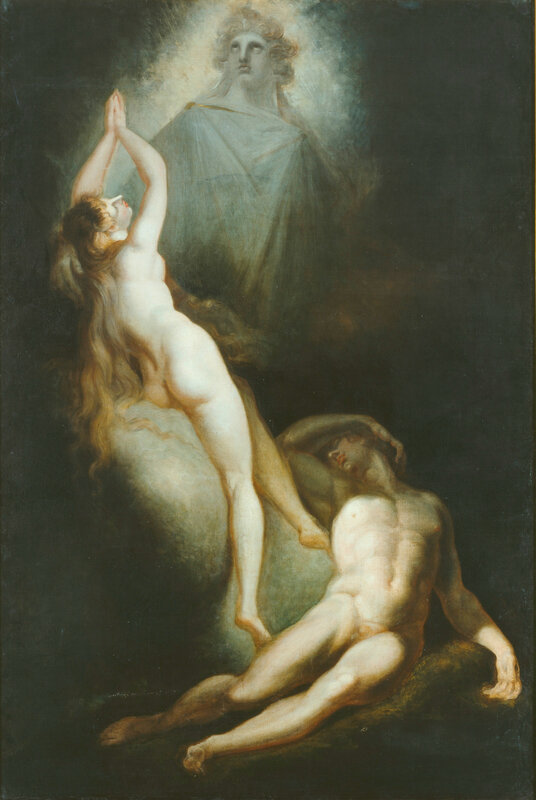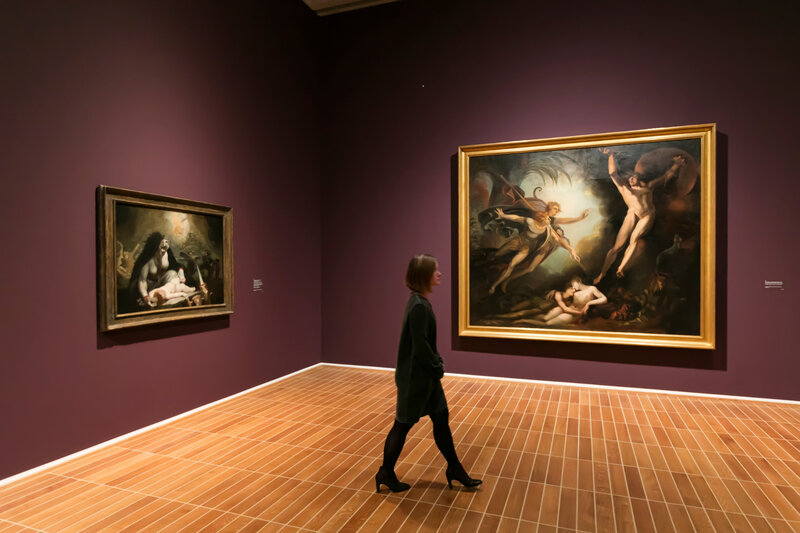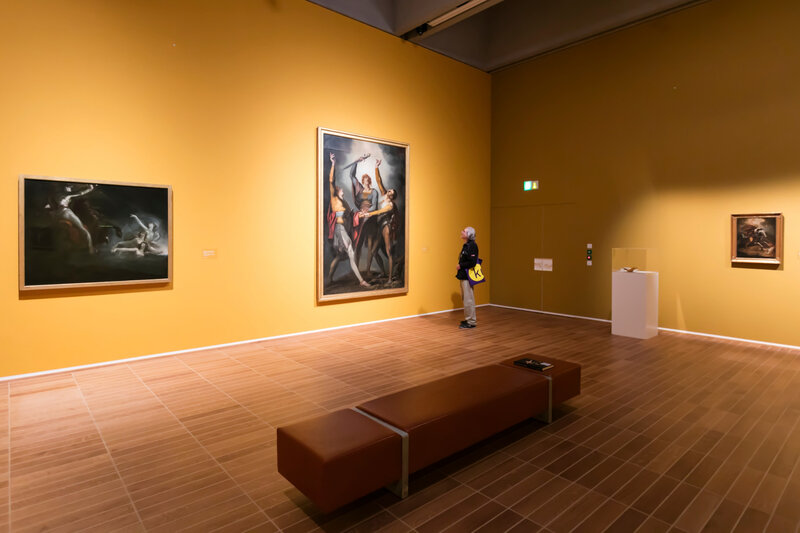First comprehensive monographic exhibition of artist Henry Fuseli on view in Basel
Johann Heinrich Füssli, Lady Macbeth, sleepwalking, around 1783. Oil on canvas, 221 x 160 cm, Louvre, Paris. Photo © RMN Grand Palais (Musée du Louvre) / Hervé Lewandowski.
BASEL.- With almost seventy paintings, the first comprehensive monographic exhibition of the work of the Swiss-born artist Henry Fuseli (1741–1825) at the Kunstmuseum Basel turns the spotlight on two of his most important sources of inspiration: literature and the stage.
Fuseli’s entire oeuvre is steeped in his engagement with the canon of great literature he began to explore during his student years in Zurich. He borrows motifs from ancient mythology, John Milton’s Paradise Lost, or Shakespeare’s dramas and stages them in “theatrical” tableaus: highly effective compositions in which hard lighting throws the strained and contorted bodies of his heroes and virgins into sharp relief, while visions of specters, fallen angels, fairies, and other supernatural apparitions make for spectacular and often lugubrious fantastic scenes. Spanning the shift from classicism to Romanticism, Fuseli’s art jettisons convention to unfurl a panorama of his idiosyncratic imagination.
Johann Heinrich Füssli, The creation of Eve, 1791-1793. Oil on canvas, 307 x 207 cm. © Hamburger Kunsthalle / bpk Photo: Elke Walford.
The “Shakespeare of canvas”
Having spent several years in Rome, Fuseli returned to London in 1779 and soon caused a sensation with illustrations of the dramas of Shakespeare. The exhibition Fuseli. Drama and Theatre showcases large-format paintings based on A Midsummer Night’s Dream, Macbeth, and Hamlet that the self-taught artist created for two literature galleries dedicated to Shakespeare; these and other works earned him the nickname “Shakespeare of canvas.” From 1790 until 1800, Fuseli himself pursued the project of a Milton Gallery, several key works from which are also on display.
Fuseli’s public image as an eccentric “Wild Swiss,” as he was known in London, is largely due to the scandalous success of The Nightmare; we present the version now in a private collection in Basel. Wider audiences primarily know the artist as a pioneer of Dark Romanticism and “Gothic horror.” The exhibition at the Kunstmuseum Basel limns a more comprehensive portrait of the man of letters with a brilliant gift of visual invention, surrounding the viewer with his painterly translations of epic plots and surveying his literary universe as well as his dramatic imagination.
Visitors are introduced to the sources from which Fuseli drew inspiration in sections dedicated to ancient and medieval legends, his study of recent and contemporary works such as Christoph Martin Wieland’s Oberon, Shakespeare’s tragedies and comedies, and Milton’s epic poem Paradise Lost. A separate section is reserved for his portraits of writers and his inventions—paintings that, rather than adapting an existing literary model, depict “sentiments personified,” which the artist sometimes embedded in narrative contexts of his own devising.
Johann Heinrich Füssli, The crazy Kate, 1806/07. Oil on canvas, 91.8 x 71.5 cm. © Freie Deutsches Hochstift / Frankfurt Goethe Museum, Photo: Ursula Edelmann.
International and multimedia
Like Fuseli’s art, Drama and Theatre does not aim for subtlety, and so the focus is on painting as the medium best suited to the artist’s quest for stirring effects. Almost seventy paintings exemplify the spectacular as well as intellectually ambitious art he created during his London decades. The seven works in the Öffentliche Kunstsammlung Basel, the municipal art collection of Basel, are complemented by generous loans from the Kunsthaus Zürich; the Folger Shakespeare Library, Washington, D.C.; the Yale Center for British Art, New Haven; the Louvre; the Tate, London; the Metropolitan Museum of Art in New York; and other Swiss and international museums and private collections.
To bring the marriage of literature, theatre, and visual art in Fuseli’s work to life in the museum, Thom Luz, resident director at the Theater Basel, has created video projections that reflect on the evocative and sometimes mysterious quality of Fuseli’s pictures in the perspective of contemporary theatre. Antenna International has produced an audio guide that gives visitors a unique opportunity to let Fuseli himself lead them through the presentation.
Johann Heinrich Füssli, Percival frees Belisane from the enchantment of Urma, 1783. Oil on canvas, 99.1 x 125.7 cm, Tate, London.
Johann Heinrich Füssli, Cupid and Psyche, around 1810. Oil on canvas, 125 x 100 cm, Kunsthaus Zurich.
Johann Heinrich Füssli, The three confederates in the oath on the Rütli, 1779-1781. Oil on canvas, 267 x 178 cm, Kunsthaus Zurich.
Johann Heinrich Füssli, Titania caressing a note with the donkey's head, 1793/94. Oil on canvas, 169 x 135 cm, Kunsthaus Zurich.
Installation view: "Dido" (1781) and "Thetis asks Hephaestus for the weapons for Achilles" (1803). Füssli. Drama und Theater, 2018. Photo: Julian Salinas.
Installation view Shakespeare Room: "Titanias Awakening" (1785-1790), "Titania caressing a note with the donkey's head" (1793/94) and "Oberon dripping flower juice into the eyes of sleeping Titania" (1793). Füssli. Drama und Theater, 2018. Photo: Julian Salinas.
Installation view: "Lady Macbeth, sleepwalking" (around 1783) and "The three witches appear before Macbeth and Banquo" (1800-1810). Füssli. Drama und Theater, 2018. Photo: Julian Salinas.
Installation view: "The Nightmare" (1810). Füssli. Drama und Theater, 2018. Photo: Julian Salinas.
Installation view: "Milton's wife, Mary Powell, who had maliciously abandoned him, begs his forgiveness" (1799/1800) and "Milton's vision of his second wife" (1799/1800). Drama und Theater, 2018. Photo: Julian Salinas.
Installation View: "Satan Flees, Touched by Ithuriel's Spear" (1779), "The Vision of the Flood" (c. 1800), "The Triumphant Messiah" (1802), "The Expulsion from Paradise" (1802) and "The Creation of Eve"(1793). Füssli. Drama und Theater, 2018. Photo: Julian Salinas.

Installation view: "Dido" (1781). Füssli. Drama und Theater, 2018. Photo: Julian Salinas.
Installation View: "Satan Flees, Touched by Ithuriel's Spear" (1779) and "The Vision of the Flood" (c. 1800). Füssli. Drama und Theater, 2018. Photo: Julian Salinas.
Installation View: "The Wild Huntress on her Flight to the Lappish Witches" (1794-1796) and "Satan Flees, Touched by Ithuriel's Spear" (1779). Füssli. Drama und Theater, 2018. Photo: Julian Salinas.
Installation View: "Milton as a Child, Taught by His Mother" (1796-1799), "Milton as a Young Man, Viewed by an Italian Lady" (1796-1799), "The Vision of the Flood" (c. 1800), "Milton's Wife, Mary Powell, who had maliciously abandoned him, begs his forgiveness" (1799/1800) and "Milton's Vision of His Second Wife" (1799/1800). Füssli. Drama und Theater, 2018. Photo: Julian Salinas.
Installation view: "A mother with her family in the countryside" (1806/07), "The newspaper in the country" (1806/07), "The crazy Kate" (1806/07) and "Undine comes to the fishing couple" (1821). Füssli. Drama und Theater, 2018. Photo: Julian Salinas.
Installation view: "Death of Cordelia" (1810-1820), "Gertrud, Hamlet and the Spirit of Hamlet's Father" (1793), "Titania's Awakening" (1785-1790), "Titania caressing a note with the donkey's head" (1793/94 ) and "Oberon drips flower juice into the eyes of sleeping Titania" (1793). Füssli. Drama und Theater, 2018. Photo: Julian Salinas.
Installation view: "Thetis asks Hephaestus for the weapons for Achilles" (1803), "Achilles reaches for the shadow of Patroclus" (1803), "Ariadne watches Theseus in the fight with the Minotaur" (1815-1820) and "Theseus and Ariadne" (1788). Füssli. Drama und Theater, 2018. Photo: Julian Salinas.
Installation view: "The Donaunixes prophesy Hagen the unfortunate outcome of Gunther's train to Kriemhild and Etzel" (c. 1800-1815), "The Three Confederates in Oath on Rütli" (1779-1781) and "Sherasmin and Hüon flee from Oberon" ( 1804/05). Füssli. Drama und Theater, 2018. Photo: Julian Salinas.
Installation view: "Thetis asks Hephaestus for the weapons for Achilles" (1803), "Achilles reaches for the shadow of Patroclus" (1803), "Ariadne observes Theseus in the fight with the Minotaur" (c. 1815-1820) and "Theseus and Ariadne" (1788). Füssli. Drama und Theater, 2018. Photo: Julian Salinas.
Installation View: "The Wild Huntress on her Flight to the Lappish Witches" (1794-1796), "Satan Flees, Touched by Ithuriel's Spear" (1779) and "The Vision of the Flood" (c. 1800). Füssli. Drama und Theater, 2018. Photo: Julian Salinas.

/https%3A%2F%2Fprofilepics.canalblog.com%2Fprofilepics%2F1%2F0%2F100183.jpg)
/https%3A%2F%2Fstorage.canalblog.com%2F03%2F02%2F119589%2F96711876_o.jpg)
/https%3A%2F%2Fstorage.canalblog.com%2F11%2F31%2F119589%2F94773502_o.jpg)
/https%3A%2F%2Fstorage.canalblog.com%2F20%2F83%2F119589%2F94772815_o.jpg)
/https%3A%2F%2Fstorage.canalblog.com%2F26%2F72%2F119589%2F75604929_o.jpg)
/https%3A%2F%2Fstorage.canalblog.com%2F59%2F60%2F119589%2F26458628_o.jpg)
























/http%3A%2F%2Fstorage.canalblog.com%2F03%2F51%2F119589%2F113069044_o.jpg)
/http%3A%2F%2Fstorage.canalblog.com%2F69%2F44%2F119589%2F95482366_o.jpg)
/image%2F1371349%2F20240425%2Fob_c453b7_439605604-1657274835042529-47869416345.jpg)
/image%2F1371349%2F20240425%2Fob_59c6f0_440358655-1657722021664477-71089985267.jpg)